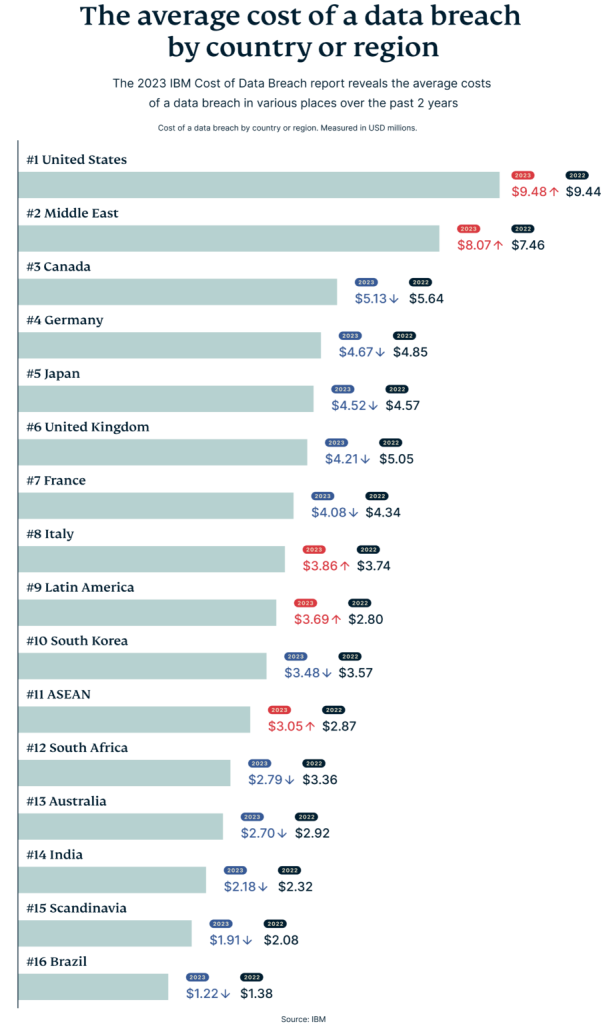Cyberattacks are increasing with the increasing penetration of the internet across different countries. The attacks not only affect individuals but sometimes pose substantial risks to governments and corporations. Forecasts indicate that the global economic toll from these attacks will increase to 10.5 trillion USD in 2025 from an astounding 8 trillion USD in 2023.

The attacks are significantly increasing and impact several industries. In recent years, we have even seen some countries accuse others of cyber security concerns. In a recent example, China accused the US of having Huawei servers. A new report Cost of Data Breach from IBM reveals average losses reaching $4.45 million per attack in recent years. The cyber attacks were estimated at $8 trillion in 2023, and they could reach 9.5 trillion in 2024. Apart from business disruptions, cyberattacks contribute the most to crippling businesses across the globe, as per a survey by Statista.
Well, the losses are going to escalate in the coming years. According to Statista and Cybersecurity Ventures predictions, the losses due to cybersecurity thefts are going to increase to $10.5 trillion in 2025. Further, it will increase to $11.3 trillion in 2026 and 12.4 trillion in 2027. However, these numbers are projected considering the current scenario; however, these may change as AI inclusion will further increase the losses.
Cyber Attack Details Across Different Industries
Precisely, the healthcare industry suffered a loss of around $10.93 million in 2023. Sensitive information in the healthcare sector, such as personal information, Social Security numbers, and other details, attracts the culprits. It leads to identity theft, insurance fraud, and even extortion in rare cases.
Meanwhile, the manufacturing industry accounted for 30% of attacks in the last year. The industry’s inability to cope with any downtime that halts production often leads to companies paying the ransom. A chipset manufacturer, TSMC, confirmed a cybersecurity incident and data breach where the culprit demanded a ransom of $70 Million.
The IT sector itself is a major target due to being the backbone of digital work across different sectors. It even has a major impact on other services, which is another reason that cybercriminals often target IT companies.
Apart from the industries, high-profile individuals are often the last of the cybercriminals. The list includes prominent politicians, industrialists, and other influential figures.
Understanding the impact of cyber attacks on various industries
The landscape of cyber threats is indeed evolving rapidly, with data breaches, ransomware, social engineering, supply chain attacks, and AI-generated threats posing significant risks to businesses and individuals alike.
In 2023, IBM research shows that the average cost of data breaches globally has surged, reaching 4.45 million USD, with the United States bearing the highest average cost in 2023. The severity of data breaches is evident from incidents like those affecting Real Estate Wealth Network, Comcast Cable Communications, Delta Dental of California, and Integris Health, which compromised billions of records containing personal information.

However, the Middle East is trailing the US with a loss of $8.07 million and then Canada with a $5.13 million data breach. The rest of the list includes Germany, Japan, the United Kingdom, France, Italy, Latin America, South Korea, and others.
Different Attacks That Cripple Industries
For a deeper dive into the evolving cyber threat landscape, including the types of attacks, their impacts, and strategies for protection, read on:
Phishing: Cybercriminals impersonate legitimate organizations to steal sensitive information via email, text, or other channels, targeting human error rather than system vulnerabilities.
Ransomware: Malicious software encrypts files until a ransom is paid, with global attacks surging by 55% in 2023, affecting 4,368 cases.
DDoS Attacks: Overwhelming online services with traffic from multiple sources, DDoS attacks disrupt operations and lead to revenue loss.
Malware: Harmful software infiltrates systems, allowing unauthorized access and espionage, with Trojans comprising 58% of all malware.
Data Extortion: Cybercriminals steal sensitive data and demand ransom, posing threats of public exposure or sale of stolen data.
Man-in-the-Middle Attacks (MitM): Intercepting and possibly altering communication between two parties, MitM attacks lead to theft of personal and financial information.
The projected increase in the cost of cyber attacks underscores the urgency of addressing cybersecurity vulnerabilities and implementing robust defense mechanisms. Both businesses and individuals must prioritize cybersecurity efforts to mitigate risks and minimize the impact of cyber threats.
There’s a dire need to invest in cybersecurity infrastructure and legislation to combat cyber threats. In a rapidly evolving digital landscape, proactive measures are critical to safeguarding against cyber attacks and mitigating their potentially devastating impacts.
Related:
- Microsoft’s Cyber Secrets at Risk, The Strontium Cyber Threat Unmasked
- Massive leak reveals more about Insomniac’s Wolverine game
- Get $100 Off on Vivo X100 Pro at Giztop
- Get the Realme GT5 Pro phone on Giztop for $599
- Best Smartphones Awards 2023
- Best VR / AR Headsets of 2023







